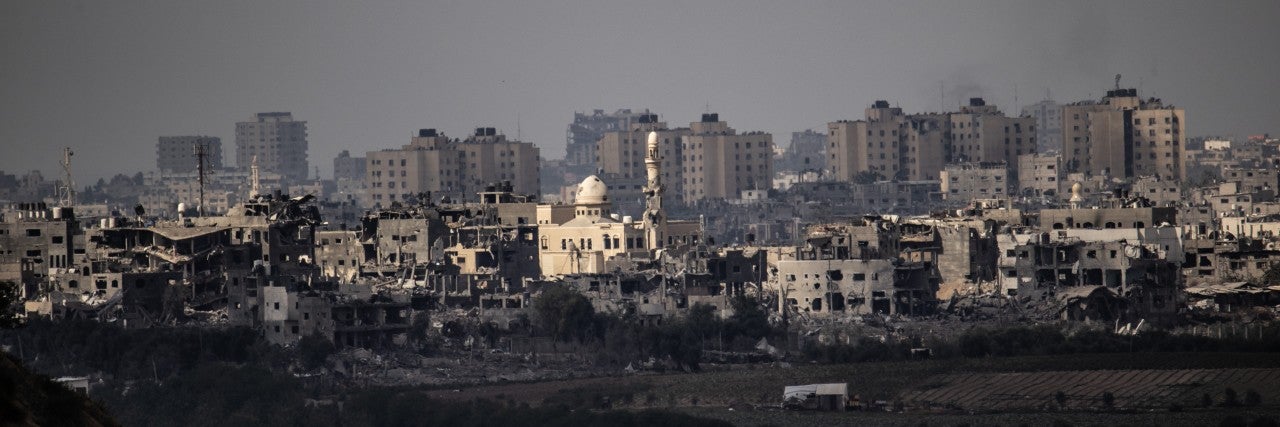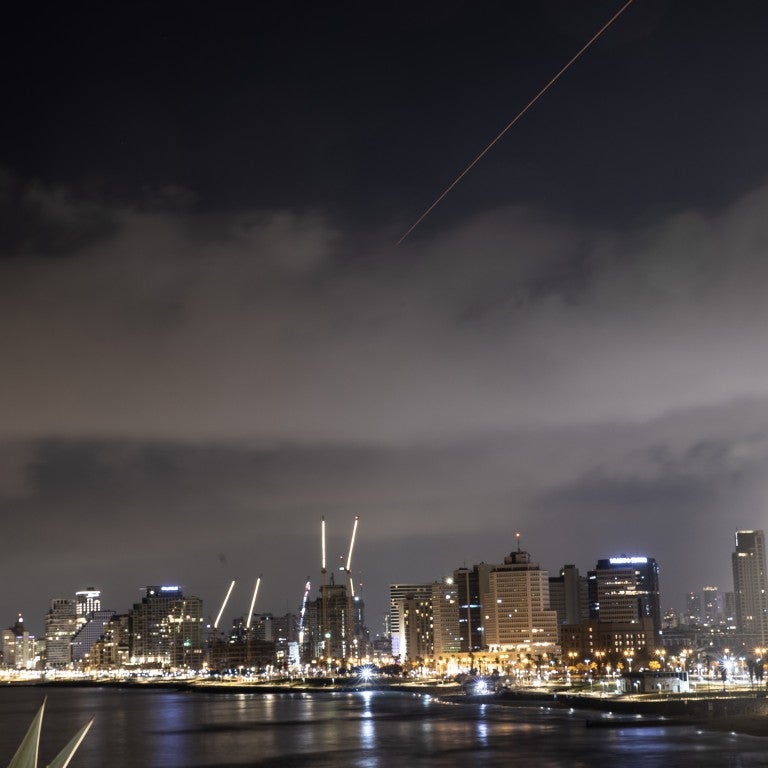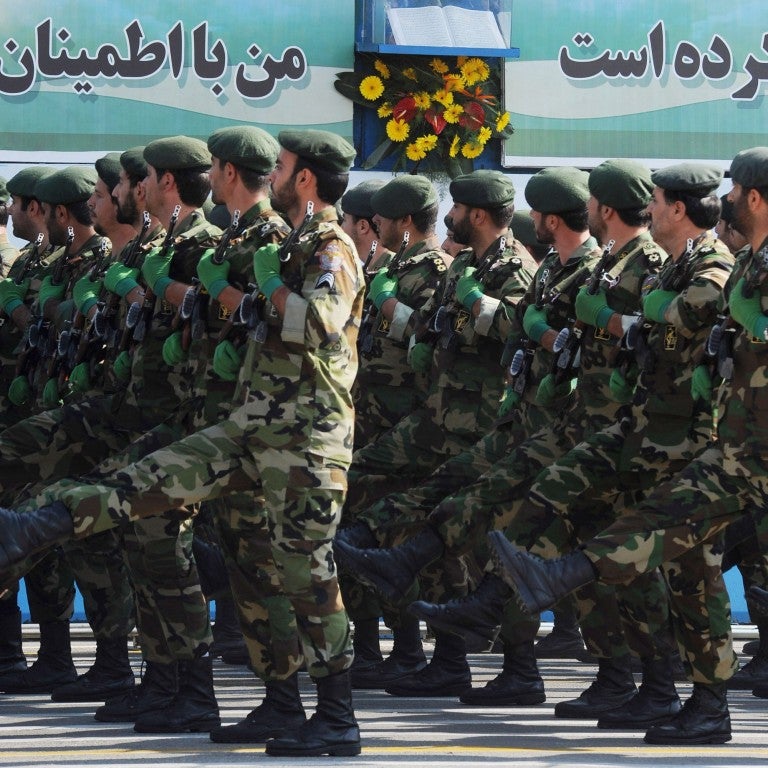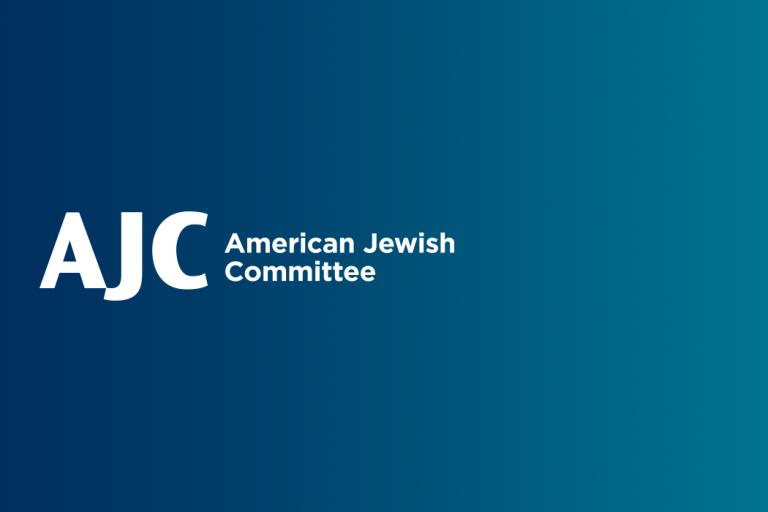February 26, 2024
The Gaza Strip is a 141-square-mile Palestinian enclave located near Israel’s southwestern tip. Bordering Egypt, Israel, and the Mediterranean Sea, the territory is home to over two million Palestinians. Its name is derived from the ancient city of Gaza, the largest city in the territory.
After Israeli withdrawal in 2005, the coastal territory has been under the control of the Iran-backed Hamas terrorist group, which violently ousted the Fatah-controlled Palestinian Authority in 2007. Hamas has used Iranian support to launch several significant attacks against Israel from its base in Gaza, including in 2008, 2009, 2014, 2021, and most recently on October 7, 2023, when Hamas terrorists murdered over 1,200 Israelis, wounded over 12,000, taken close to 134 hostages, and launched thousands of rockets.
Here are common questions about Gaza, the terror group that controls it, and the Israel-Hamas War.
American Jewish Committee (AJC) is tackling several tough questions and topics in 2023. What should we answer next? Email us at toughquestions@ajc.org to let us know.
Israel’s Actions
Does Israel occupy the Gaza Strip?
No. Some media accounts of the Gaza Strip often blame Israel’s “occupation” as one of the root causes of the conflict. However, Israel does not occupy the Gaza Strip and has had no permanent presence in the coastal enclave for nearly two decades.
From 1948 to 1967, the Gaza Strip was occupied by Egypt, which took control of the territory during the 1948 Arab-Israeli War, also known as Israel’s War of Independence. As a result of the 1967 Six-Day War, Israel gained control over the Gaza Strip from Egypt.
In 2005, Israel, overcoming huge political pushback, withdrew from the Gaza Strip, dismantling its settlements and military installations in the name of peace and in hopes of creating a better future.
Israel and Egypt maintain strict blockades over Gaza to block the smuggling of weapons and monitor the misuse of materials by terror groups. This blockade began soon after the Hamas’ takeover of Gaza and amid fears of Iranian arms shipments and that Hamas would repurpose humanitarian aid to use as deadly weapons against Israel. Examples of this include pipes for rockets and cement for attack tunnels.
Israel has long provided humanitarian aid to the Gaza Strip through coordination with international organizations, allowing the transfer of goods and aid through specific border crossings while inspecting shipments for security purposes. This assistance includes food, medical supplies, and specialized medical treatment for Gaza residents. Israel also coordinates the supply of electricity and fuel, critical for essential infrastructure.
Is Israel trying to colonize the Gaza Strip?
No. All eyes are on Gaza at the moment, but we cannot lose sight of that in 2005, Israeli Prime Minister Ariel Sharon made the difficult decision to pull out of Gaza - to completely remove Israeli forces from the land. During that period of withdrawal, Sharon said, "Now the Palestinians bear the burden of proof. They must fight the terror organizations, dismantle their infrastructures, and show sincere intentions of peace."
Eighteen years later, it is beyond heartbreaking to know that the hopes that were once held for Gaza to be a land of peace, the heart of what could have been a wider peace process, have been utterly destroyed by the hate and evil of Hamas and their ideology.
The Jewish people have a history and a religion that connects them to the land of Israel, which dates back thousands of years. And for close to 100 years, there have been attempts to overcome and find a solution to the Israeli-Palestinian conflict. In 1947, 1993, 1999, 2005, and 2007, there were repeated attempts to make peace. During each period, not only did the Palestinian leadership reject compromise, but they also responded to many of those opportunities with hate and terror.
Is Israel carrying out ethnic cleansing in Gaza?
No. On October 12, Israel told some 1.1 million people in the northern Gaza Strip to evacuate toward the southern part of the coastal territory ahead of an expected ground operation and in order to avoid extensive casualties as it targets Hamas terrorist infrastructure, much of which is buried deep underground. IDF spokesman Jonathan Conricus said that the IDF would make “extensive efforts to avoid harming civilians” and that residents would be allowed to return when the war is over.
The goal for Israel is to end the terror threat posed by Hamas after it carried out the world’s deadliest terrorist attack in the country’s history on October 7. Israel, which pulled its citizens out of the Gaza Strip in 2005, has no long-term plan to control the territory, nor does it have any plans to remove the Palestinian population there. It is simply trying to defend itself from Hamas terrorism.
Is Israel faking deaths as an excuse to attack Palestinians?
No. Most of the international community has been shocked and horrified by the inhumane atrocities carried out by Hamas terrorists against civilians in Israel during its attack on October 7.
The level of brutality carried out by Hamas terrorists has also drawn comparisons to the worst atrocities carried out by Islamic State terrorists in Iraq and Syria in 2014. Using rape, torture, and even beheadings, Hamas simply terrorized Israeli civilians in towns and kibbutzim along the border, including the Supernova music festival, where 260 young Israelis and foreign nationals were slaughtered, and the Kibbutz Be’eri Massacre where over 100 people were killed.
Does Israel target Palestinian hospitals and schools in Gaza?
No. Israel’s military operations in Gaza target terrorist groups and their infrastructure, and any civilian casualties or damage to civilian infrastructure is unintentional.
According to the United Nations, tens of thousands of Gazans have relocated south since Israel’s warnings. Many of the residents who have remained in the north have done so at the urging, intimidation, and enforcement of Hamas. Hamas wants residents to remain as human shields and to use their deaths as propaganda. Additionally, Hamas is preventing foreign nationals from leaving Gaza.
Hamas stores weapons in residential areas and even schools and hospitals, firing rockets from densely populated zones, operating command centers in civilian areas, and sometimes using civilian clothing to blend in. Such practices make it challenging for the Israeli military to target legitimate military assets without risking civilian casualties.
Israel takes intense measures to minimize civilian harm, issuing warnings before airstrikes in populated areas. For example, Israel warns civilians by dropping thousands of leaflets in Arabic, making text messages or phone calls to Palestinian civilians, and uses a tactic called “roof knocking, " utilizing a warning projectile as a final attempt to get residents to evacuate a building before targeting it for destruction.
For more information about Hamas’ Lie About the October 17 rocket strike on a Gaza Hospital, please click here.
Does Israel use excessive force against Palestinian civilians?
No. Israel’s military actions in Gaza are a response to threats and actions from Palestinian terrorist groups, such as Hamas and Palestinian Islamic Jihad, who, in addition to the latest, unprecedented massacre, use tactics like firing rockets from civilian areas such as schools, hospitals, and mosques.
Unlike its terror group adversaries, who purposely target civilian populations, Israel adheres to the laws of war in its military operations in Gaza, following principles such as necessity, distinction, proportionality, and taking precautions to protect civilians. Israel makes efforts to target combatants and military objectives while minimizing harm to civilians, provides advance warnings before certain operations, and coordinates humanitarian assistance for Gaza's civilian population.
- Necessity - Israel is exercising its inherent right of self-defense, enshrined in the UN Charter, in response to Hamas’s attacks. Israel is entitled to continue exercising this right until it eliminates the ongoing threat posed by Hamas.
- Distinction - The IDF adopts a strict approach with many checks and verifications to distinguish military targets from civilian ones, which roughly parallels the U.S. military’s approach.
- Proportionality - Israel frequently aborts military operations against verified military targets when it determines civilians remain in the area—even if it has already warned such civilians and encouraged them to evacuate. The IDF requires that military lawyers review all decisions regarding targets and strikes to ensure Israel is complying with international law. When Hamas violates the principle of distinction by carrying out operations from civilian sites, those sites become legitimate military targets.
Why is the death toll for Palestinians so high in Gaza? Does Israel target Palestinian civilians?
Palestinian terror groups such as Hamas often place military assets, including rocket launchers, within or near civilian areas such as hospitals and schools, which makes it difficult for Israeli forces to target these assets without causing civilian casualties.
Furthermore, Gaza is a densely populated territory, and its residents are near areas where hostilities occur. This proximity increases the risk of civilian casualties during military operations.
Despite these challenges, Israel goes to great lengths to avoid civilian deaths in the Gaza Strip. Israel has developed and deployed early warning systems to alert civilians in areas where military strikes are imminent. This includes air raid sirens and phone messages to warn residents of impending attacks. Israel has used a practice called "roof knocking" where non-explosive munitions are fired at a target building to warn occupants to evacuate before a real strike occurs.
Unlike Hamas, which fires rockets indiscriminately at Israeli civilian areas, Israel employs advanced technology and precision-guided munitions to target military assets while minimizing collateral damage and the risk to civilians.
Nevertheless, it is important to remember that Israel is in a defensive war following the worst terrorist attack in the country’s history on October 7. By launching this attack and murdering over 1,200 Israelis and other foreign nationals, while also taking 199 people hostage, Hamas has committed grave violations of international war and war crimes. Through its military operations in Gaza, Israel is working to end the terror murderous threat posed by Hamas and safely return the hostages.
Has Israel not made any serious offers of peace with the Palestinians?
Israel has extended its hand in peace time and time again, including several concrete offers and proposals for peace with the Palestinians over the years. Here are some of the significant Israeli offers for peace with the Palestinians:
Oslo Accords (1993 and 1995): Israel, under the leadership of Prime Minister Yitzhak Rabin, signed the Oslo Accords with the Palestine Liberation Organization (PLO) headed by Yasser Arafat. The accords established the Palestinian Authority and granted limited self-governance to Palestinians in the West Bank and Gaza Strip. While only a transitional agreement, the Oslo Accords were seen as a significant step towards a two-state solution.
Camp David Summit (2000): Then-Israeli Prime Minister Ehud Barak and U.S. President Bill Clinton hosted Palestinian leader Yasser Arafat for negotiations at Camp David in 2000. Barak offered significant territorial concessions to the Palestinians, including the establishment of a Palestinian state in most of the West Bank and Gaza Strip with East Jerusalem as its capital. However, the talks failed to produce a final agreement with Palestinian leader Yasser Arafat rejecting the offer. Commenting later, President Bill Clinton said that Arafat missed a historic opportunity for peace.
The collapse of the Camp David Summit was eventually followed by the Second Intifada, which saw widespread terrorist attacks, including suicide bombings carried out by Palestinian terror groups, that led to a significant loss of life on both sides.
Annapolis Conference (2007): In 2007, Israeli Prime Minister Ehud Olmert and Palestinian Authority President Mahmoud Abbas, with the support of the U.S., launched the Annapolis Conference. The goal was to reach a peace agreement that would lead to the establishment of a Palestinian state. Olmert said that he gave Abbas an “unprecedented offer” based on a return to the pre-1967 borders, including land swaps and a division of Jerusalem. But Olmert never received a final response from the Palestinians on the offer.
More recently, the Trump Administration unveiled the “Peace to Prosperity” plan in January 2020. The plan presented a vision for a two-state solution but with certain parameters, including Israeli sovereignty over some settlements in the West Bank and a non-contiguous Palestinian state.
Throughout its evolution, the two-state solution has been a central concept in Israeli-Palestinian negotiations and international diplomacy. However, obstacles such as territorial disputes, security concerns, the status of Jerusalem, settlements, and the right of return for Palestinian refugees have hindered progress.
Nevertheless, Israel has consistently expressed support for a two-state solution. Various Israeli leaders and governments have endorsed this concept in principle, including Prime Minister Benjamin Netanyahu, who endorsed it in 2009 and again expressed an openness to it earlier this year, supporting a demilitarized Palestinian state. Israeli Opposition Leader Yair Lapid has also endorsed a two-state solution last year when he was prime minister.
Why are there calls for a ceasefire and why is that a loaded question?
Many parties are calling for a ceasefire from both Israel and Hamas, in order to prevent further bloodshed. The problem with this call is that it ignores two critically important points:
- Israel has just experienced the most catastrophic attack on its soil in its history. It has every right to respond to defend itself, as any nation would. Recognizing Israel’s right to defend itself means respecting Israel’s right to set its war goals and pursue them as it deems best.
- Israel has fought multiple wars against Hamas in Gaza, including in 2008, 2012, 2014, 2021. In each case, Israel agreed to a ceasefire, due to pressure from the international community. In repeated conflicts, Hamas has broken those ceasefires.
Until October 7, the underlying assumption was that Hamas’ ideological goal of destroying the Jewish State existed in tandem with a pragmatic interest in governing Gaza. Hamas’ actions on October 7 destroyed those assumptions.
Calling for a ceasefire gives Hamas credit and authority it no longer deserves. The United States and other Western powers must stand by Israel as it pursues the only option left to it after 16 years of trying every other option to deter Hamas and force it to abandon its stated goal of destroying Israel.
Israel is a democracy with clear laws. The IDF will conduct this war in keeping with internationally recognized standards. Every reasonable effort will be made to protect innocent civilians.
Is violence in the West Bank growing as a result of the Israel-Hamas War?
As a result of the October 7 massacre, the IDF has been conducting raids in the West Bank targeting Hamas terrorists located in the area. The media and the Palestinian Authority are also reporting a simultaneous rise in settler violence against Palestinian civilians. The State of Israel has repeatedly and continuously condemned settler vigilantism. Israel has the burden and responsibility to restrain settlers seeking to intimidate, threaten, or harm Palestinian civilians.
Humanitarian Aid To Gaza
What is the status of humanitarian aid in the Gaza Strip?
On October 18, Israel agreed to allow humanitarian aid to enter Gaza from Egypt, in order to mitigate a major humanitarian crisis in Gaza and save innocent Palestinian lives. AJC welcomed this crucial decision to save the lives of civilians held in the crossfire by Hamas and stated that this isn't Israel's war alone. It’s a battle against terrorists and those who support them. Israeli officials said that food and medicine will also be allowed into Gaza. On October 15, it was reported that, in a conversation between PM Netanyahu and President Biden, Israel is now providing water supply to southern Gaza Strip.
However, Israel has not committed to also allowing electricity and fuel supplies into Gaza.
Despite being controlled by a terrorist organization that is dedicated to Israel’s destruction, Israel long provided humanitarian aid to the Gaza Strip through coordination with international organizations, allowing the transfer of goods and aid through specific border crossings while inspecting shipments for security purposes. This assistance has included food, medical supplies, and specialized medical treatment for Gaza residents. Israel also coordinated the supply of electricity and fuel, critical for essential infrastructure.
It is important to note that, according to the laws of war, countries are not required to supply their enemies with food, water, electricity, and gasoline, all of which supports the enemy’s capacity to fight. Yet, even during previous rounds of fighting, Israel continued to supply Gaza with electricity, water, food, and medicine. The decision to cut off such supplies following October 7 is a direct result of the viciousness of Hamas’ attacks.
In addition, the Gaza Strip has been given billions of dollars in humanitarian aid over the last several years - including over $1 billion dollars from Qatar. Hamas has diverted much of that humanitarian aid intended for the Palestinian people for its own purposes, including funding its terrorist activities such as building terror tunnels and rocket factories.
How much humanitarian aid has been sent to Gaza by the U.S., by Israel, and by other agencies?
Israel and Egypt maintain strict blockades over Gaza to block the smuggling of weapons and monitor the misuse of materials by terror groups. This blockade began soon after the Hamas’ takeover of Gaza and amid fears of Iranian arms shipments and that Hamas would repurpose humanitarian aid to use as deadly weapons against Israel. Examples of this include pipes for rockets and cement for attack tunnels.
However, through its Kerem Shalom Border crossing, Israel has sent thousands of tons of aid and food, fuel, and medical supplies for Gazans. Additionally, Israel had granted permits to about 17,000 Gaza residents to enter and work in Israeli communities to relieve the dire humanitarian situation brought on by Hamas control. International aid groups provide food and other means of support to about 63% of people in Gaza. Israel has worked to facilitate the transfer of humanitarian goods into the territory.
After President Donald Trump cut Palestinian aid in 2018, the Biden administration in 2021 reinstated help for Palestinians in Gaza and the West Bank, sending more than $360 million that year.
The State Department said the money would be used to support “humanitarian organizations to provide emergency shelter, food, relief items, and health care, as well as mental health and psychosocial support for those who experienced trauma.” About $10 million was earmarked to “support programs that support reconciliation work to reduce tension and violence over the long term.” Under the Taylor Force Law, no money went to programs that directly benefit the Palestinian Authority.
At the time, Secretary of State Antony Blinken said the aid would be used for “urgent, humanitarian reconstruction assistance for Gaza” after an 11-day war between Israel and Hamas in May 2021.
Gaza Under Hamas Control
Why does Hamas control Gaza?
Palestinian voters elected Hamas to power in 2006. Hamas’ election was seen at the time as a repudiation of the long-dominant Palestinian political party Fatah, which was widely seen as corrupt. but not because of its charter to destroy the Jewish state.
The year after Hamas was elected, the terror group staged a brutal and bloody takeover of Gaza, ousting Fatah officials, dissolving the unity government, and dividing the Palestinian territories between Gaza and the West Bank. There have been no elections since.
Half of the population of Gaza is so young that they were born after Hamas’s takeover. They have been ruled by Hamas for their entire lives.
Do Palestinians support Hamas?
Not the majority. A Washington Institute poll conducted in July 2023 found that 62% supported Hamas maintaining a ceasefire with Israel. 50% agreed that “Hamas should stop calling for Israel’s destruction, and instead accept a permanent two-state solution based on the 1967 borders.” While reliable polling data is always difficult to gauge, what is clear is that Hamas’ initial appeal came from Hamas’ humanitarian support for Palestinians, as well as its perception that it was less corrupt than the Palestinian Authority.
According to a September 2023 poll by the Palestinian Center for Policy and Survey Research, 27% of Palestinians polled said that Hamas is deserving of representing the Palestinian people - this is in contrast to 24% who say Fatah is most deserving and 44% who say neither party is deserving. In the same poll, 49% of polled Palestinians said that if elections were held today, they would vote for Marwan Barghouti of Fatah, followed by 36% for Ismael Haniyyah of Hamas and 13% for Mahmud Abbas of Fatah.
All these numbers need to be viewed in perspective. The vast majority of Palestinians see their current situation as bad to very bad, creating an environment where extremism and hatred grow and fester.
Does Egypt blockade the Gaza Strip?
From 1948 to 1967, the Gaza Strip was occupied by Egypt, which took control of the territory during the 1948 Arab-Israeli War, also known as Israel’s War of Independence. As a result of the 1967 Six-Day War, Israel gained control over the Gaza Strip from Egypt.
Today Egypt maintains a land border with the Gaza Strip, known as the Rafah Border Crossing. It is located in the city of Rafah, which is divided between the Gaza Strip and Egypt's Sinai Peninsula. The border crossing serves as one of the primary entry and exit points for people and goods traveling between the Gaza Strip and Egypt.
The crossing has been a subject of political and security tensions over the years. It has been periodically closed or restricted by both the Egyptian and Israeli governments due to security concerns and political disputes.
Egypt, along with Israel, also maintains a blockade of the Gaza Strip. The primary purpose of the blockade is to restrict the flow of weapons and military materials to Hamas, the Palestinian terrorist group that controls the Gaza Strip. Both Israel and Egypt have raised security concerns about the potential for weapons smuggling and the threat posed by Hamas.
Egypt also has a complex relationship with Hamas. Hamas is an offshoot of Egypt’s Muslim Brotherhood, which has been designated as a terrorist organization since 2013. Egypt outlawed the Muslim Brotherhood after the military ousted President Mohammed Morsi.
What is the status of the blockade after October 7? What is the strategic purpose of cutting off food and water to Gaza? What is preventing aid from coming from Egypt into Gaza?
The actions to this point by Hamas justify a blockade. Hamas has smuggled in weapons and enough weapon components to create thousands of rockets, which have been fired towards Israel. Its members have converted water pipes into rocket launchers and taken cement for their tunnel infrastructure.
Israel, though announcing early that it would cut off food and water supply, is currently allowing for humanitarian shipments to enter Gaza and supplying the region with water. AJC supports this decision by Israel. Israel continues to block fuel from entering Gaza as it is being used to launch missiles.
It is also important to note that Hamas has been stockpiling food, water, and oil for some time and is using these supplies for their own purposes rather than to alleviate the humanitarian crisis in Gaza. There are recent reports of Hamas going into UNRWA schools and stealing their supplies.
There have been several humanitarian convoys allowed in from Egypt. The issue over the flow of humanitarian aid is ongoing, and being negotiated and changed on a day-to-day basis. Ultimately, while Israel wants to help civilians, it needs assurances that aid will go to the people of Gaza and not Hamas.





